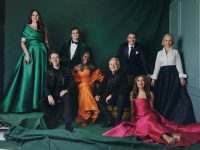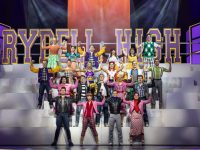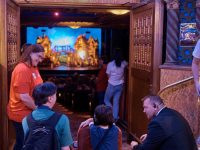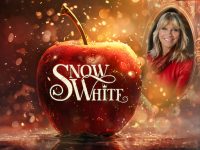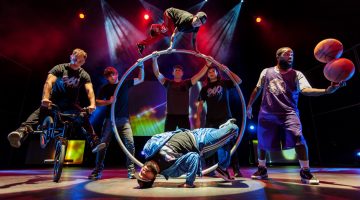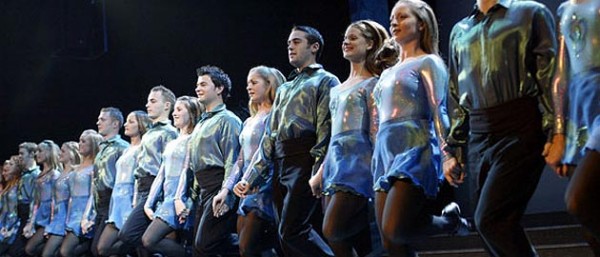
In the mid nineties the world experienced a host of various percussive dance shows. Not since the Hollywood ‘Golden’ era, had tap dance been so popular. Who started it?, is a question for the ages. There is no doubt, in the early nineties, globally (and well before the convenience of the internet), somehow the performance art of physical percussion and/or percussive dance incubated and spread throughout the international stage. There is no scientific way of predicting how it possible for so many shows, so diverse yet similar in nature, could be created at the same time but somehow, they were all a huge success. Penetrating the social conscience and securing, by their individual merit, a place in dance history. Two examples of this have played seasons at Sydney’s Capitol Theatre this year.
As a co-founder of Tap Dogs and original cast member of Hot Shoe Shuffle, I find myself at Opening Night of Riverdance having never seen it. I was always in the other city or country at the time and never enjoyed the opportunity. I’d heard tales of Michael Flatley (the show’s original star) and discussed the relevance of his Guinness Book World Record in May 1989 for tapping speed at 28 taps per second with my peers, yet not seen the spectacle that is Riverdance live, until now.
Riverdance was first performed during the 7-minute interval of the Eurovision Song Contest at the Point Theatre, Dublin on 30 April 1994. Due to a high demand from viewers, after it was replayed on television, a creative team set about building a full-length show. Produced and directed by husband and wife team John McColgan and Moya Doherty with a score written by Bill Whelan, Riverdance, opened at the Point Theatre in Dublin for the first full-length performance on 9 February 1995. The show ran for five weeks and was a sell-out. The show has since toured the world and has been hugely successful. I spoke with Julian Erskine, the executive producer of Riverdance and he explained, ‘Never before, had there been such a thing as a professional Irish Tapper’. Julian also pointed out, ‘there was no precedent to touring 20 Irish tappers and maintaining them physically’. A new era of physical therapy was born. Some fun facts, since 1995; 45000 rolls of self grip tape used by company physiotherapists, 1 650 000 show programs sold, 12000 costumes worn, 14000 dance shoes used, 1500 Irish Dancers and 35 marriages between company members.
Without an obvious theatrical narrative, Riverdance presents as an exhibition of a traditional Irish dance and some. The Irish style is, on this occasion en masse, a dance that uses minimal arms. One drummer/percussionist and 3 very lonely looking musicians dress the stage, the massive sound they generated was obviously assisted by a click track. With a quasi spiritual/agricultural documentary and a rudimentary projection display of spiritual/agricultural images as a subtle guide, the show features ensemble routines interspersed with musicians’ solos, female songbird and male & female protagonists. Certainly and largely delivered, he explodes onto the stage with bravado and athleticism (and angular arm use), choreographed with the opportunity of superior beat delivery to that of his chorus. His female shone with the contrasting solos and theatrical ‘damsel in distress’ scenarios, all very formal. Add a sprinkling of juxtaposed Spanish ‘flamenco’ dance and the reward of our protagonists’ inevitable coupling we arrive at interval.
I did wonder to myself, with all due respect, what all the fuss is about. Act one had some very stirring music and was a fine display of Irish tap, but I find it hard to believe that the show I was seeing could possibly be the huge phenomenon that I’d heard so much about. Maybe this was a touring production, stripped down to the bare minimum. 20 Irish tappers being a bare minimum is impressive and a darn fine employer of dancers, my hat is off to you, touring production of Riverdance. If that’s the case, the original must have been HUGE.
A lower class (on the f-deck of the Titanic) style party greets us from our intermission and everyone’s happy. Traditional dresses and costumes almost confuse the audience into thinking the choreography is different and the chorus gets to dance in couples. The show takes a sudden twist when an African American vocalist sings a song, of which has no obvious relevance, but proves an alternative (it’s a fun fact that his head microphone failed and the sound guy replaced his amplification by walking onto the stage ‘in time’ with the dancers as they continued and the singer accepted the hand held like it was a new born baby). The ‘theatre’ of Riverdance is explored in no uncertain terms during the 2nd Act. Quite possibly, the most polite way of demonstrating the comparison between Irish Tap Dance and African American hoofing is paraded before an audience. 2 hoofers trade it off with the Irish Tappers. Carefully, ‘Irish’ and ‘African American Hoofers’ dual it out in a hilarious de-construction of political correctness, wisecracking and one-upmanship to boot. As an accomplished tapper myself, I feel I’ve earned the right to judge – they all missed way too many beats for professional tappers. And they got away with it by tomfoolery, cheap showmanship and clowning around using buskers’ theatrics (this is precisely what Savion Glovers’ ‘Bring In Da Noise, Bring In Da Funk’ commentaries). Please don’t get me wrong, I would forgive and enjoy the whole charade if they had nailed all the tap beats. The show winds up with the usual stirring music and a very impressive ensemble finale. Well-done Irish tappers.
There doesn’t seem to be much honest theatrical merit to this particular production of Riverdance but I can certainly see the echo of the spectacle it once was and surrounding me on opening night were the vestiges of a once mighty force. Audience members re-living the romance and undeniable passion of a powerful and entertaining dance art – Irish dance.
BTW, as mentioned in the first sentence of this article, ‘In the mid nineties the world experienced a host of various percussive dance shows’. Allow me to explain. As I see it, Hot Shoe Shuffle was ‘commercially’ first, followed closely by Stomp, closely followed by Tap Dogs and then followed even closer by Riverdance. In reality, it went Stomp, HSS, Riverdance, and Tap Dogs. I can confirm that the seed for what was to become Tap Dogs was planted during the season of 42nd St at Her Majesty’s Theatre in late ’89 (between the likes of Dein Perry, Myself, Drew Anthony, Sheldon Perry, Andrew Hallsworth, Paul Davis, Ben Read, Adam Garcia and others).

